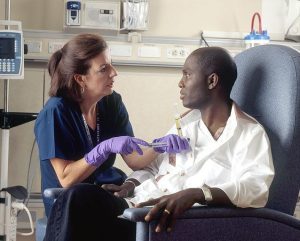Advocacy as a Professional Behavior
Tamara Berghout
Learning Objectives
- Evaluate how nurses’ professional behaviors influence individuals, nurses, and patients.
- Analyze advocacy from the perspective of a professional nurse leader.
This week, we will review how every nurse is responsible for client, professional, and personal advocacy and examine the powerful influence nurses can have on local, state, and federal healthcare policies that affect the nation’s health and the profession of nursing.

Advocacy
What do you think of when you hear the word “advocacy”? Advocacy is defined as the act or process of pleading for, supporting, or recommending a cause or course of action[1]. Advocacy may be demonstrated for individuals, groups, organizations, communities, society, or policy issues. Advocacy is one of the ANA’s Standards of Professional Performance. The Standards of Professional Performance are “authoritative statements of the actions and behaviors that all registered nurses, regardless of role, population, specialty, and setting, are expected to perform competently.”[2][/footnote] See the following list to read the competencies associated with the ANA’s Advocacy Standard of Professional Performance.
Competencies of ANA’s Advocacy Standard of Professional Performance
- Champion the voice of the health care consumer.
- Recommend appropriate levels of care, timely and appropriate transitions, and allocation of resources to optimize outcomes.
- Promote safe care of health care consumers, safe work environments, and sufficient resources.
- Participate in health care initiatives on behalf of the health care consumer and the system(s) where nursing happens.
- Demonstrate a willingness to address persistent, pervasive systemic issues.
- Inform the political arena about the role of nurses and the vital components necessary for nurses and nursing to provide optimal care delivery.
- Empower all members of the health care team to include the health care consumer in care decisions, including limitation of treatment and end-of-life care.
- Embrace diversity, equity, inclusivity, health promotion, and health care for individuals of diverse geographic, cultural, ethnic, racial, gender, and spiritual backgrounds across the life span.
- Develop policies that improve care delivery and access for underserved and vulnerable populations.
- Promote policies, regulations, and legislation at the local, state, and national levels to improve health care access and delivery of health care.
- Consider societal, political, economic, and cultural factors to address social determinants of health.
- Role model advocacy behavior.
- Address the urgent need for a diverse and inclusive workforce as a strategy to improve outcomes related to the social determinants of health and inequities in the health care system.
- Advance policies, programs, and practices within the health care environment that maintain, sustain, and restore the environment and natural world.
- Contribute to professional organizations.
Advocacy for Clients

It is essential for nurses to act as advocates for their clients (e.g., individuals, families, communities, or populations) by protecting their “patient rights” and voicing their needs. Nurses have a long history of acting as client advocates. There are many examples of how nurses have advocated in the past. for example, early nurses advocated for professional nurses’ value and knowledge and fought for implementation of best practices, safety measures, and other quality improvements. Florence Nightingale advocated for practice changes that improved environmental conditions in health care and reduced life-threatening infections by using data to support her recommendations. Lillian Wald worked to establish public health nursing and improve the lives of immigrant communities.
More recently, nurses led the establishment of Nurse Practice Acts in each state and pushed for multistate licensing via the Nurse Licensure Compact (NLC). The American Nurses Association (ANA) declared 2018 as the “Year of Advocacy” to highlight the importance of advocacy in the nurse’s role. Nurses continue to advocate for building healthier communities as demonstrated in the Future of Nursing 2020-2030: Charting a Path to Achieve Health Equity report.[4]
Read the Future of Nursing 2020-2030: Charting a Path to Achieve Health Equity. The Future of Nursing: Campaign for Action at https://med.libretexts.org/Bookshelves/Nursing/Nursing_Management_and_Professional_Concepts_(OpenRN)/10%3A_Advocacy/10.01%3A_Advocacy_Introduction [5]
Advocacy for Society
National, state, and local policies impact nurses at all levels of care, from nurse administrators to bedside nurses, making it essential for nurses to take an active role in advocating not only for their clients, but also for their profession, and their community. At the community level, nurses can advocate for improved access to basic health care, enhanced funding of health care services, and safe practice environments by participating in policy discussions. Nurses can also participate in state and national policy discussions affecting nursing practice. For example, nurses have advocated for the removal of practice barriers so nurses can practice according to the full extent of their education, certification, and licensure. Nurses have alslo advocated for reimbursement based on the value of nursing care and the expansion of nursing education.[6]t
For another example of how nurses advocated for their patients, and for themselves, watch this video from the Service Employees International Union (SEIU) [7]:
Advocacy for Your Profession and Yourself
Nurses should also advocate for themselves, their well-being, and their fellow professionals. Nurses can advocate for improvements in the workplace via various mechanisms, such as shared governance and the ANCC Magnet Recognition Program, and by participation in professional organizations. Nurses can also seek legislative solutions for workplace problems by advocating for legislation such as whistleblower protection, organizational issues in the nursing profession and the workplace through participation in unions, collective bargaining, workplace advocacy models, and professional organizations.
When advocating, nurses must view themselves as knowledgeable professionals who have the power to influence policy and decision-makers. A nurse can advocate for improved policies through a variety of pathways. Each method provides a unique opportunity for the nurse to impact the health of individuals and communities, the profession of nursing, and the overall health care provided to clients. These are few easy ways for nurses to get involved:
- Joining and becoming involved in professional nursing organizations
- Engaging in conversations with local, state, and federal policymakers on health care related issues
- Participating in shared governance committees regarding workplace policies
Summary
Nurses are in a powerful position to be effective advocates. As frontline care providers, nurses provide a unique and knowledgeable perspective on health care delivery, client experience, and the work environment. As the largest sector of the health care workforce, nurses have the opportunity to influence policy at every level of decision-making. There are many ways for nurses to create change when acting as advocates that can lead to improved quality of care, better outcomes for patients, and safe work environments for nurses. If every nurse was an active advocate for the profession, think of the difference we could make; and, if nurses were willing to work together, think of the added value the collective actions could have.
Exercise
Go to ANA Advocacy #BedsideAndBeyond Webpage examples at https://ana.aristotle.com/SitePages/YearOfAdvocacy.aspx Then choose one example of what other nurses have done (note that there are many examples under the different categories, just select one of the down arrows, and then you can select them to see more). Then you will be prepared to participate in the weekly discussion.
Media Attributions
- Nurses Parade, Chicago is licensed under a Public Domain license
- Nurse Administers Chemotherapy © Rhoda Baer (Photographer) is licensed under a Public Domain license
- Oxford Language Dictionary. (2023). Advocacy. https://languages.oup.com/google-dictionary-en/ ↵
- [footnote]American Nurses Association. (2021). Nursing: Scope and standards of practice (4th ed.). American Nurses Association. ↵
- American Nurses Association. (2021). Nursing: Scope and standards of practice (4th ed.). American Nurses Association. ↵
- National Academies of Sciences, Engineering, and Medicine. (2021). The Future of nursing 2020-2030: Charting a path to achieve health equity. The National Academies Press. https://doi.org/10.17226/25982↵ ↵
- Ernstmeyer & Christman (Eds.). Policy introduction. https://med.libretexts.org/Bookshelves/Nursing/Nursing_Management_and_Professional_Concepts_(OpenRN)/10%3A_Advocacy/10.01%3A_Advocacy_Introduction ↵
- American Nurses Association. (2021). Nursing: Scope and standards of practice (4th ed.). American Nurses Association. ↵
- Service Employees International Union. (2001). The fight for our lives: How we won safer needles. https://www.youtube.com/watch?v=g51WkB9zpEk&t=5s ↵
- Ernstmeyer & Christman (Eds.). (n.d.). Policy Advocacy. https://med.libretexts.org/Bookshelves/Nursing/Nursing_Management_and_Professional_Concepts_(OpenRN)/10%3A_Advocacy/10.05%3A_Policy_Advocacy#footnote-1019-1 ↵

